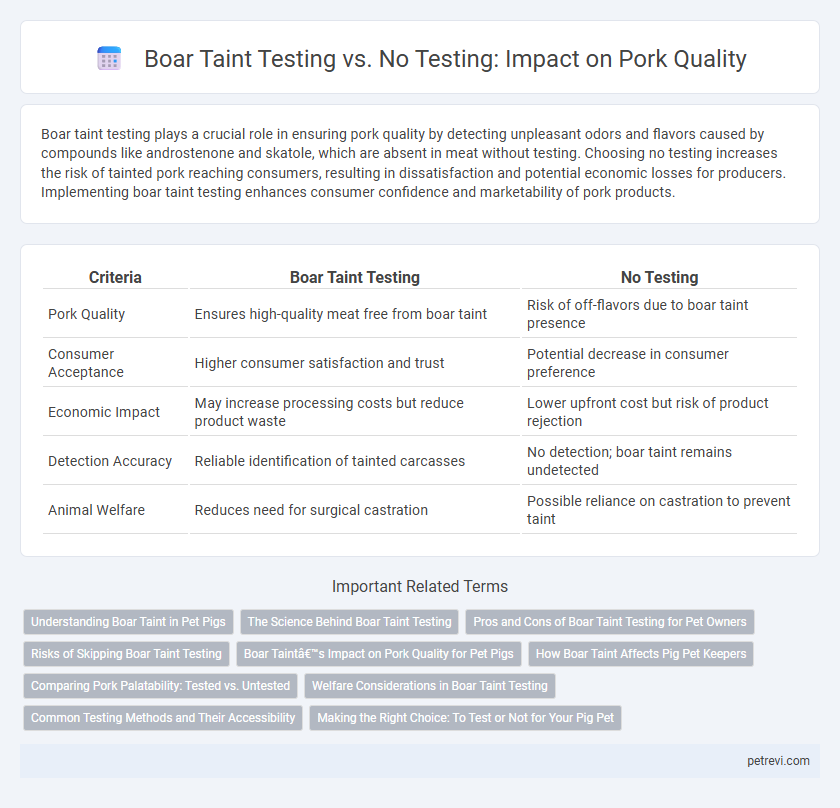Boar taint testing plays a crucial role in ensuring pork quality by detecting unpleasant odors and flavors caused by compounds like androstenone and skatole, which are absent in meat without testing. Choosing no testing increases the risk of tainted pork reaching consumers, resulting in dissatisfaction and potential economic losses for producers. Implementing boar taint testing enhances consumer confidence and marketability of pork products.
Table of Comparison
| Criteria | Boar Taint Testing | No Testing |
|---|---|---|
| Pork Quality | Ensures high-quality meat free from boar taint | Risk of off-flavors due to boar taint presence |
| Consumer Acceptance | Higher consumer satisfaction and trust | Potential decrease in consumer preference |
| Economic Impact | May increase processing costs but reduce product waste | Lower upfront cost but risk of product rejection |
| Detection Accuracy | Reliable identification of tainted carcasses | No detection; boar taint remains undetected |
| Animal Welfare | Reduces need for surgical castration | Possible reliance on castration to prevent taint |
Understanding Boar Taint in Pet Pigs
Boar taint, primarily caused by androstenone and skatole, significantly affects pork quality and consumer acceptance, making boar taint testing crucial in pet pigs used for consumption. Testing methods, such as sensory evaluation and chemical analysis, help detect these compounds early, ensuring that meat from entire male pigs is free from unpleasant odors and flavors. Without testing, the risk of tainted pork increases, compromising meat quality and market value.
The Science Behind Boar Taint Testing
Boar taint testing detects androstenone and skatole compounds responsible for unpleasant flavors in pork, ensuring meat quality and consumer acceptance. Analytical methods, such as GC-MS (Gas Chromatography-Mass Spectrometry), provide precise quantification of these compounds, enabling early identification of affected carcasses. Implementing testing reduces the risk of tainted pork reaching markets, enhancing product consistency and supporting animal welfare by avoiding unnecessary castration.
Pros and Cons of Boar Taint Testing for Pet Owners
Boar taint testing ensures pork from entire male pigs is free from unpleasant odors, enhancing meat quality and safety for pet consumption. It reduces risks of off-putting flavors caused by compounds like androstenone and skatole, which can affect pets' appetite and health. However, testing increases production costs and may limit availability of boar-tainte free meat, affecting price and accessibility for pet owners.
Risks of Skipping Boar Taint Testing
Skipping boar taint testing in pork production significantly increases the risk of unpleasant odors and flavors caused by compounds like androstenone and skatole, leading to consumer rejection and reduced market value. This practice compromises product quality assurance, resulting in potential economic losses for producers and processors due to returned or unsold meat. Failure to detect boar taint can also damage brand reputation and erode consumer trust in pork products.
Boar Taint’s Impact on Pork Quality for Pet Pigs
Boar taint significantly affects pork quality by causing an unpleasant odor and flavor, which diminishes consumer acceptance of pet pig meat. Implementing boar taint testing ensures early detection of androstenone and skatole compounds, maintaining the sensory quality and market value of pork products from pet pigs. Without testing, elevated levels of these compounds can lead to rejection of meat, resulting in economic losses and reduced consumer trust in pet pig pork.
How Boar Taint Affects Pig Pet Keepers
Boar taint, caused by compounds like androstenone and skatole, generates an unpleasant odor and flavor in pork that is particularly noticeable to pig pet keepers sensitive to their animals' welfare and meat quality. Without boar taint testing, pig pet keepers risk accepting meat with off-putting sensory defects, affecting consumer satisfaction and diminishing trust in pork products. Implementing boar taint testing enhances pork quality assurance, ensuring that pet keepers receive odor-free, high-quality meat aligned with ethical and culinary standards.
Comparing Pork Palatability: Tested vs. Untested
Boar taint testing significantly improves pork palatability by identifying and removing tainted meat that contains off-putting odors from compounds like androstenone and skatole. Pork from tested boars consistently scores higher in sensory evaluations, showing enhanced tenderness, flavor, and overall consumer acceptance compared to untested pork. Avoiding testing risks lower meat quality and increased consumer rejection due to unpleasant taste and aroma associated with boar taint.
Welfare Considerations in Boar Taint Testing
Boar taint testing significantly improves welfare considerations by reducing the need for surgical castration, which is associated with pain and stress in pigs. Non-invasive methods such as genetic testing and saliva analysis enhance animal well-being while maintaining pork quality control. Avoiding testing often leads to widespread castration, negatively impacting pig welfare and raising ethical concerns in pig farming practices.
Common Testing Methods and Their Accessibility
Boar taint testing commonly employs methods such as sensory evaluation, chemical analysis of androstenone and skatole levels, and immunocastration to prevent undesirable flavors in pork. Sensory panels require trained evaluators, while chemical assays like gas chromatography-mass spectrometry (GC-MS) provide precise quantification but may be cost-prohibitive for small producers. Immunocastration offers a practical alternative by reducing boar taint compounds biologically, increasing accessibility for varied pork quality assurance needs.
Making the Right Choice: To Test or Not for Your Pig Pet
Boar taint testing is essential for ensuring high pork quality by detecting unpleasant odors caused by androstenone and skatole in uncastrated male pigs. Opting not to test increases the risk of off-flavors that can decrease consumer acceptance and market value. Making the right choice involves balancing testing costs against the benefits of maintaining premium pork standards.
Boar taint testing vs No testing for Pork quality Infographic

 petrevi.com
petrevi.com